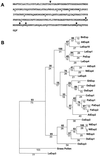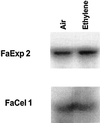An expansin gene expressed in ripening strawberry fruit
- PMID: 10594114
- PMCID: PMC59494
- DOI: 10.1104/pp.121.4.1273
An expansin gene expressed in ripening strawberry fruit
Abstract
Tissue softening accompanies the ripening of many fruit and initiates the processes of irreversible deterioration. Expansins are plant cell wall proteins proposed to disrupt hydrogen bonds within the cell wall polymer matrix. Expression of specific expansin genes has been observed in tomato (Lycopersicon esculentum) meristems, expanding tissues, and ripening fruit. It has been proposed that a tomato ripening-regulated expansin might contribute to cell wall polymer disassembly and fruit softening by increasing the accessibility of specific cell wall polymers to hydrolase action. To assess whether ripening-regulated expansins are present in all ripening fruit, we examined expansin gene expression in strawberry (Fragaria x ananassa Duch.). Strawberry differs significantly from tomato in that the fruit is derived from receptacle rather than ovary tissue and strawberry is non-climacteric. A full-length cDNA encoding a ripening-regulated expansin, FaExp2, was isolated from strawberry fruit. The deduced amino acid sequence of FaExp2 is most closely related to an expansin expressed in early tomato development and to expansins expressed in apricot fruit rather than the previously identified tomato ripening-regulated expansin, LeExp1. Nearly all previously identified ripening-regulated genes in strawberry are negatively regulated by auxin. Surprisingly, FaExp2 expression was largely unaffected by auxin. Overall, our results suggest that expansins are a common component of ripening and that non-climacteric signals other than auxin may coordinate the onset of ripening in strawberry.
Figures






References
-
- Brummell DA, Harpster MH, Dunsmuir P. Differential expression of expansin gene family members during growth and ripening of tomato fruit. Plant Mol Biol. 1999;39:161–169. - PubMed
-
- Cosgrove DJ. Plant cell enlargement and the action of expansins. BioEssays. 1996;18:533–540. - PubMed
-
- Cosgrove DJ. Assembly and enlargement of the primary cell wall in plants. Annu Rev Cell Dev Biol. 1997;13:171–201. - PubMed
-
- Feinberg A, Vogelstein B. A technique for radiolabeling DNA restriction endonuclease fragments to high specific activity. Anal Biochem. 1983;132:6–13. - PubMed
Publication types
MeSH terms
Substances
LinkOut - more resources
Full Text Sources
Other Literature Sources

